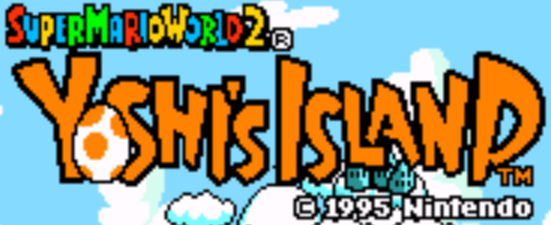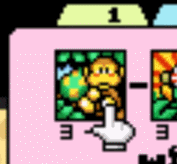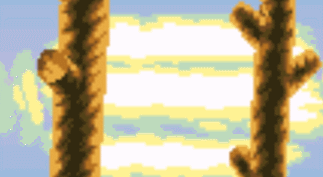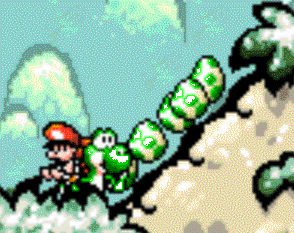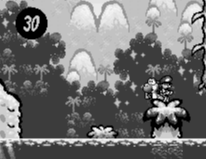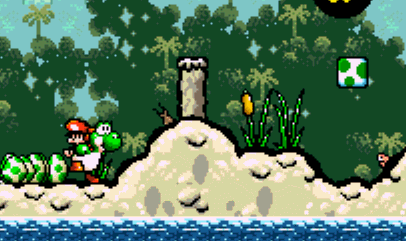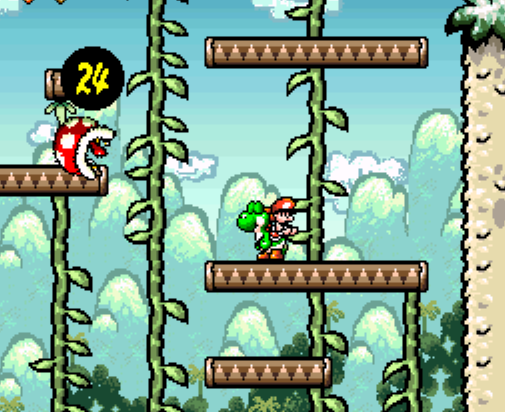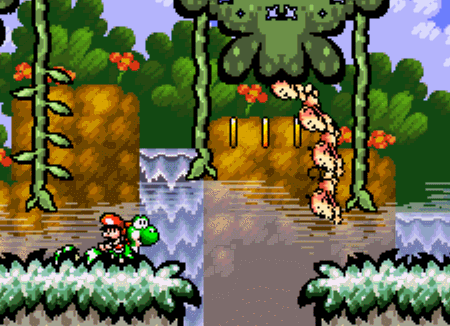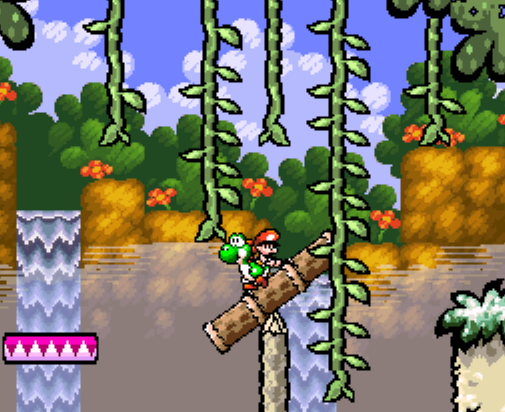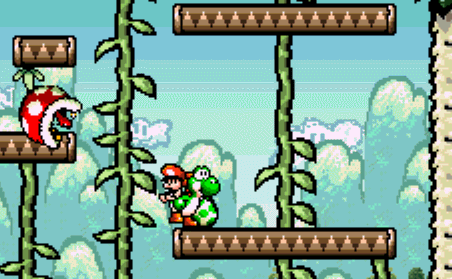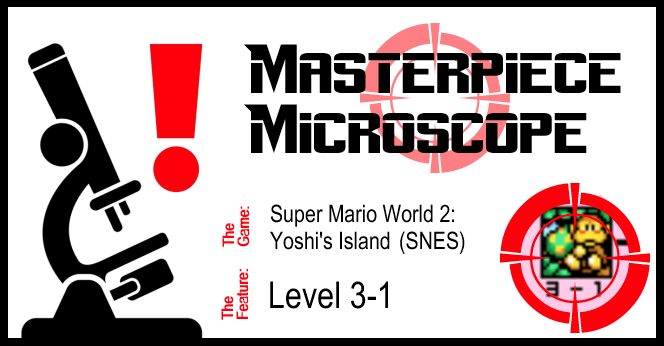
Masterpiece Microscope
Yoshi’s Island Level 3-1
Masterpiece Microscope is a series in which I choose one great video game, then focus intensely on a single specific feature of its gameplay. Upon close examination, we may gain new insight as to just how great the game is, along with a better appreciation for the quality work that went into every little detail.
Somewhere in the game-loving part of my mind is a spectrum. At one end is Formula; that is, the cold, rational mathematics behind game design. Great graphics + sound + gameplay = great game. Throw in some sensible user interface, move around a few pixels and polygons to their utmost perfect positions, maybe tweak that level design a bit, and you have the foundation for a rewarding experience.
On the other end of that spectrum is Whimsy. This is the area where conniving developers hide their giddy secrets, where artists spend hours trying to get the facial expression of a background character just right for no particular reason, where players delight at bonuses and extras. This is where we encounter the extravagantly unnecessary.
And when I consider examples of video games that contain a great many exhibits of the wonderfully unnecessary, I quickly think of Yoshi’s Island.
Ah, Yoshi’s Island! What a delightful title. Its cartridge is utterly stuffed to the brim with Whimsy. I could point to many instances, but for this Masterpiece, let us put the Microscope on one element: Level 3-1. Subtitle: Welcome To Monkey World!
Now, let’s be honest, Yoshi’s Island already has some notoriety for quirky level design. I think many gamers will remember, with varying levels of disdain, such classics as Touch Fuzzy Get Dizzy. We could talk about the inspired randomness behind Shy Guys On Stilts. We know about the boss battles, we are familiar with how the Super FX chip was used to great effect in the scaling sprite animations. If you are not aware of these wonders, I recommend playing Yoshi’s Island, but I would have done so in a general sense anyway. For today, for this column, we are just going to focus intensely on 3-1.
Quick question: The last time you played this stage, did you notice the nice, hazy sunset? Did you notice that it is animated?
The clouds stick out much more noticeably, for sure.
For the most part, Welcome To Monkey World! could be cast off as your standard jungle-theme fare. You have your trees, your shades of green, your monkey creatures, your platforms, your sky, your protagonist navigating vines, your hills, your other what-have-you. I must insist, however, that the designers had way more fun with this section of Island than you may have realized at first glance.
Our first inkling arrives with Exhibit A: The Half-Eaten Watermelon.
A refresher: In Yoshi’s Island, Yoshi can consume a watermelon in order to gain the ranged weaponry power of spitting its seeds at foes. There are even red watermelons that enable the spitting of fireballs, and icy blue watermelons that let Yoshi freeze enemies with blasts of arctic-chilled breath.
That alone is pretty neat and distinctive, the fruit-as-arsenal idea. Really, just having one type of watermelon would have already been memorable, not to mention the extra-mile caveat of the seed trajectories being varied, rather than simply firing in a straight line. Honestly, would you have noticed or cared whether or not those seeds merely fired in a line or at angles? Check it out.
Then the devs had to go to the next level and, at some point, think, “Hey, not only should we have weaponized melons, but we should have monkeys that hold a half-eaten one. See, this makes the monkeys seem a little more like real beasts within the machine, and we will incorporate a mechanic whereas eating the half-eaten melons grants less projectile ammo.” That was an actual, real-life thought process.
May we talk about the mud? There are some physics in place just for the muddy parts of stages like 3-1. The mud behaves as you would expect, sort of. On hills, it slows Yoshi’s walking pace to about half speed when he traverses upward; then, when he stops, he slowly slides back down as well, all while little flecks of wet dirt fling from his feet.
Then we have this amazing sequence.
First of all, those weird tilty islands are kinda cool. But then, to go under the hillwater, into the sky, for a super fun 1UP-packed mini-game-like portion? Nifty, reminiscent of an old Super Mario Bros 3 trick, and completely uncalled for.
Next, we have an ingredient in the whimsy stew that, all by itself, was the inspiration for this article. This is The One Single Thing that compelled me to write on Yoshi’s Island, and its unnecessary extravagances. This next item really does not add a single gram of gameplay value, and had to take some time resources away from other development, and only exists for the enjoyment of the viewer. Behold: The frogs.
I found a blue one, too!
Take a moment to imagine the conversation that may have happened in some developmental meeting. “Wait,” an excited dude or dudette says, “Let’s have frogs! Like, okay, these little toads, they hop around in the mud, y’know? It’s totally atmospheric, a setting thing, and Yoshi can’t even interact with them, but they’ll interact with the environment. They can’t be killed or eaten or stomped or whatever, but they’ll be stopped by obstacles, move away from Yoshi’s presence, and be able to splash into the water. We’ll make a few different palette swaps for ’em, too!”
What? Why?
Because it is wonderful.
Let us not forget this vertical segment of 3-1, wherein we discover Pirahna Plants perched precariously upon the patforms and hanging from them and such. They feel so out of place, or maybe that is just my impression. Why are they there?
We will get back to them.
Remember the vine of monkeys? Brilliant execution. Ever since the days of Pitfall (Pitfall!), we know that a swinging vine can be used to traverse a gap. Here we are, presented with some innocuous simians, forming a friendly rope for us to use, except…
THEY TAKE THE BABY AND YOU DIIIIIIIIE.
Which is very funny, and something every Yoshi player must endure their first time through as a sort of initiation rite.
We have here a log balancing puzzle, which is definitely a platforming trope – yet, with our Little Tilty Islands seen earlier in the stage, means that they bothered to put two different flavors of balancing acts in one level. Insanity.
Okay, maybe that was a silly example, perhaps I am making a mountain out of a mudhill there. Instead, do you recall those misplaced pirahna plants? Let us solve the mystery of their appearance there.
If you have ever enjoyed Yoshi’s Island to its fullest extent, you know that the player is charged with a scorekeeping system per every level. A total of 100 is the goal, with different point values assessed for three different items collected: Flowers, red coins, and stars. The star guys also double as your counter for providing time to rescue Baby Mario when Yoshi is hit.
In other words, it is possible to find all the red coins and flowers, but have to work your star counter back up from being contacted by hostiles. How does one build up the star counter? Well, stars can be found fairly reliably in question-mark clouds – but Yoshi also has a built-in system for generating stars.
In order to do so by himself, Yoshi needs to throw an egg in such a way that it bounces off two different surfaces before killing an enemy character. Then, a couple smiley stars will pop out the corpse.
So what does this have to do with those devilish Pirahna Plants?
Stay with me here, dear reader: In an interior environment, like a castle or a cave, Yoshi has a very easy time finding spots to double-bounce eggs into enemies. After all, he can either go wall-ceiling, floor-wall, or even floor-ceiling in sequence to attain the needed bounces per stars.
Outdoors, a unique problem is presented; namely, a lack of any ceiling, and often any walls. A keen player may notice that even in most of Yoshi’s Island exterior settings there are rather convenient “dug-out” areas of freestanding walls and ceilings and such, which make star recovery much easier than mere clear blue skies would provide.
In 3-1, though, if you reach the end gate with a need for stars, you have to head back to those odd Plants.
Because that is the only spot where you can double-egg-bounce your way back to a full 30-star count.
Details like that, my friend, are what make Yoshi’s Island a masterpiece when you put it under a microscope.
